|
|
 |
|
Calanoida ( Order ) |
|
|
|
Calanoidea ( Superfamily ) |
|
|
|
Paracalanidae ( Family ) |
|
|
|
Paracalanus ( Genus ) |
|
|
| |
Paracalanus denudatus Sewell, 1929 (F,M) | |
| | | | | | | Syn.: | no Calanus pygmaeus Claus, 1863 (p.174) (not clear);
Paracalanus pygmaeus : Sars, 1925 (p.24, figs.F); Rose, 1929 (p.16); 1933 a (p.74, figs.F); Massuti Alzamora, 1940 (p.4); 1942 (p.110); Vervoort, 1946 (p.126); Wilson, 1942 a (p.201); Sewell, 1948 (p.400); Farran & Vervoort, 1951 c (n°35, p.3, figs.F); Marques, 1961 (p.52); Fagetti, 1962 (p.12); Grice & Hart, 1962 (p.287, 293: Rem.); Djordjevic, 1963 (p.576); Mazza, 1966 (p.69); Razouls, 1972 (p.17, figs.F); El-Sherif & Aboul Ezz, 2000 (p.61, Table 3: occurrence); Vives & Shmeleva, 2007 (p.973, figs.F,M, Rem.); Zaafa & al., 2014 (p.67, Table I, occurrence); El Arraj & al., 2017 (p.272, table 2, spatial distribution); | | | | Ref.: | | | Sewell, 1929 (p.66, Descr.F, figs.F); Farran, 1936 a (p.80, fig.F, Rem.); Sewell, 1947 (p.51, Rem.); Tanaka, 1956 c (p.368, figs.F, Rem.); 1960 (p.24, Rem.); Vervoort, 1963 b (p.106, figs.F, Rem.); De Decker, 1964 (p.16); Grice & Hulsemann, 1967 (p.14: Rem.); Corral Estrada, 1970 (p.86, Descr.M, figs.F,M, Rem.); Park, 1970 (p.475); Silas, 1972 (p.645); Kos, 1972 (Vol. I, figs.F, Rem.); Andronov, 1977 (p.154, Rem.); Vives, 1982 (p.290); Chahsavar-Archad & Razouls, 1982 (p.27); Scotto di Carlo & al., 1984 (p.1043); Alvarez-Cadena, 1985 (tab.2); Hiromi, 1987 (p.153, Rem.); Chihara & Murano, 1997 (p.845, Pl.135: F); Bradford-Grieve & al., 1999 (p.878, 910, figs.F); Avancini & al., 2006 (p.64, Pl. 33, figs.F, Rem.); Vives & Shmeleva, 2007 (p.966, figs.F,M, Rem.); Kesarkar & Anil, 2010 (Rem.: p.405, fig.F) | 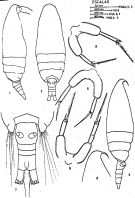 issued from : J. Corral Estrada in Tesis Doct., Univ. Madrid, A-129, Sec. Biologicas, 1970. [Lam.17]. Female (from Canarias Is.): 1, habitus (lateral right side); 2, idem (dorsal); 3, P5; 4,habitus (lateral right side, another specimen); 5, P5; 6, forehead (lateral , another specimen); 7, posterior part cephalothorax and urosome (dorsal); 8, P5.
|
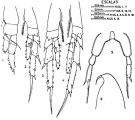 issued from : J. Corral Estrada in Tesis Doct., Univ. Madrid, A-129, Sec. Biologicas, 1970. [Lam.18, figs.1-6]. Female (another specimen): 1, P1; 2, P2; 3, P3; 4, P4; 5, P5; 6, forehead (lateral).
|
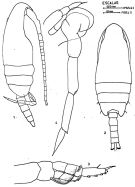 issued from : J. Corral Estrada in Tesis Doct., Univ. Madrid, A-129, Sec. Biologicas, 1970. [Lam.15]. Male: 1, habitus (lateral right side); 2, idem (dorsal); 3, P1; 4, P5.
|
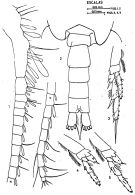 issued from : J. Corral Estrada in Tesis Doct., Univ. Madrid, A-129, Sec. Biologicas, 1970. [Lam.16]. Male: 1, A1; 2, posterior part cephalothorax and urosome (dorsal); 3, P2; 4, P4; 5, P5.
|
 issued from : R.B.S. Sewell in Mem. Indian Mus., 1929, X. [p.67, Fig.23]. Female (from Nankauri Harbour): a, habitus (lateral left side); b, urosome (dorsal); c, genital segment (ventral); d, P2; e, P3; f, P4; g, P4 (in another specimen); h, P5.
|
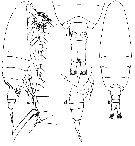 issued from : W. Vervoort in Atlantide Report., 1963, 7. [p.107, Fig.9]. Female (from off W Portugal): a-b, habitus (lateral and dorsal, respectively) (x135): c-d, posterior part cephalothorax and urosome (dorsal and lateral, respectively) (x240).
|
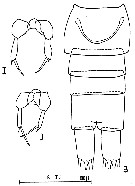 issued from : C. Razouls in Th. Doc. Etat Fac. Sc. Paris VI, 1972, Annexe. [Fig.26, B, I-J]. As Paracalanus pygmaeus. Female (from Banyuls, G. of Lion): B, urosome (dorsal); I-J, P5 (from two specimens).
|
 issued from : K.S. Kesarkar & A.C. Anil in J. mar. Biol. Ass. UK, 2010, 90 (2); [p.405, Table 2]. Characteristics of females.
|
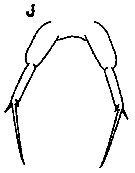 issued from : K.S. Kesarkar & A.C. Anil in J. mar. Biol. Ass. UK, 2010, 90 (2); [p.407, Fig.5, J]. Female: J, P5.
|
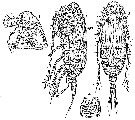 Issued from: G.O. Sars in Résult. Camp. Scient. Prince Albert I, 69, pls.1-127 (1924). [Pl.VI, figs. 1-4]. Female: 1, habitus (lateral); 2, same (dorsal); 3, forehead (lateral), showing labrum and labiums ventrally; 4, genital segment (ventral).
|
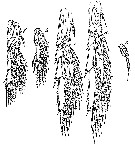 Issued from: G.O. Sars in Résult. Camp. Scient. Prince Albert I, 69, pls.1-127 (1924). [Pl.VI, figs. 5-9]. As Paracalanus pygmaeus. Female: 5, P1; 6, endopodite of P2; 7, P3; 8, P4; 9,
P5.
|
 Issued from M. Rose in Résult. Camp. scient. Prince Albert I, 1929, 78, p.16. Remarques concernant Paracalanus pygmaeus (= Paracalanus denudatus) identifié lors des campagnes de 1912, 1913 et 1914.
| | | | | Compl. Ref.: | | | Sewell, 1948 (p.357, 418, 426); Ahlstrom & Thrailkill, 1963 (p.57, Table 5, abundance); De Decker, 1964 (p.16, 23, 27); Fleminger, 1967 a (tabl.1); Delalo, 1968 (p.137); Park, 1970 (p.475); Apostolopoulou, 1972 (p.327, 336); Corral Estrada & Pereiro Muñoz, 1974 (tab.I); Patel, 1975 (p.659); Judkins, 1980 (p.475, Rem.: p. 477); Vives, 1982 (p.290); Smith S.L., 1982 (p.1331, abundance, monsoon effect); Kovalev & Schmeleva, 1982 (p.83); Scotto di Carlo & al., 1984 (1043); Brinton & al., 1986 (p.228, Table 1); Madhupratap & Haridas, 1986 (p.105, tab.1); Lozano Soldevilla & al., 1988 (p.57); Othman & al., 1990 (p.561, 563, Table 1); Siokou-Frangou, 1997 (tab.1); Hure & Krsinic, 1998 (p.26, 100); Suarez-Morales & Gasca, 1998 a (p.110); Smith S. & al., 1998 (p.2369, Table 6, moonsoon effects); Ueda & al., 2000 (tab.1); Fragopoulu & al., 2001 (p.49, tab.1); Uysal & al., 2002 (p.17, tab.1); Paffenhöfer & Mazzocchi, 2003 (p.1151, fig.8); Vukanic, 2003 (139, tab.1); Rezai & al., 2004 (p.486, tab.2, 3, abundance, Rem., p.495, tab.8); Pusch & al., 2004 (251, tab.3); Shimode & Shirayama, 2004 (p.607, tab.1, 2); Smith & Madhupratap, 2005 (p.214, tab.4, 6); Rezai & al., 2005 (p.157, Table 2, 5: spatial & temporal variations); Prusova & Smith, 2005 (p.75, 78); Isari & al., 2006 (p.241, tab.II); Khelifi-Touhami & al., 2007 (p.327, Table 1); Humphrey, 2008 (p.84: Appendix A); Wishner & al., 2008 (p.163, Table 2, fig.8, oxycline); Ohtsuka & al., 2008 (p.115, Table 4); C.E. Morales & al., 2010 (p.158, Table 1: ?); Cornils & al., 2010 (p.2076, Table 3, Fig.5); Schnack-Schiel & al., 2010 (p.2064, Table 2: E Atlantic subtropical/tropical); Mazzocchi & Di Capua, 2010 (p.426); Fazeli & al., 2010 (p.153, Table 1); Maiphae & Sa-ardrit, 2011 (p.641, Table 2, 3, Rem.); Saitoh & al., 2011 (p.85, Table 5); Isari & al., 2011 (p.51, Table 2, abundance vs distribution); Selifonova, 2011 a (p.77, Table 1, alien species in Black Sea); Mazzocchi & al., 2011 (p.1163, Table II, fig.6, long-term time-series 1984-2006); Mazzocchi & al., 2012 (p.135, annual abundance 1984-2006); Uysal & Shmeleva, 2012 (p.909, Table I); DiBacco & al., 2012 (p.483, Table S1, ballast water transport); Johan & al., 2012 (p.647, Table 1, 2, salinity range); Salah S. & al., 2012 (p.155, Tableau 1); Hidalgo & al., 2012 (p.134, Table 2); Johan & al., 2012 (2013) (p.1, Table 1); Miloslavic & al., 2012 (p.165, Table 2, transect distribution); Gubanova & al., 2013 (in press, p.4, Table 2: as P. dendatus lapsus calami); Terbiyik Kurt & Polat, 2013 (p.1163, Table 2, seasonal distribution); Cornils & Blanco-Bercial, 2013 (p.861, Table 1, molecular analysis, figs.3, 4, 5); in CalCOFI regional list (MDO, Nov. 2013; M. Ohman, comm. pers.); Hirai & al., 2013 (p.1, Table I, molecular marker); Lidvanov & al., 2013 (p.290, Table 2, % composition); Pansera & al., 2014 (p.221, Table 2, abundance); Mazzocchi & al., 2014 (p.64, Table 3, 4, 5, spatial & seasonal composition %); Benedetti & al., 2016 (p.159, Table I, fig.1, functional characters); El Arraj & al., 2017 (p.272, table 2, spatial distribution); Benedetti & al., 2018 (p.1, Fig.2: ecological functional group); Belmonte, 2018 (p.273, Table I: Italian zones) | | | | NZ: | 15 | | |
|
Distribution map of Paracalanus denudatus by geographical zones
|
| | | | | | | | | | | | | Loc: | | | South Africa (SE), Namibia, SE Atlant., ? G. of Guinea, off S Cape Verde Is., off Morocco-Mauritania, Cap Ghir, Great Meteor Seamount, Canary Is., Madeira Is., off Amazon, G. of Mexico, off W Tangier, Medit. (M'Diq, W Basin, Gulf of Annaba, Ligurian Sea, Tyrrhenian Sea, G. of Napoli, Lake Faro (Sicily), Adriatic Sea, Aegean Sea, Thracian Sea, Black Sea, Iskenderun Bay, Lebanon Basin), G. of Aqaba, Sharm Em-Sheikh, Red Sea, Gulf of Oman, G. of Aden, Arabian Sea, Somalia, Andaman & Nicobar Islands, NW India (Saurashtra coast), Macpherson Strait, Perai River estuary (Penang), Straits of Malacca, G. of Thailand, Malaysia (Sarawak: Bintulu coast), SW Celebes, Viet-Nam (Cauda Bay), China Seas (South China Sea, East China Sea, 24°56'N-127°59'E), Japan, Palau Is., Australia (G. of Carpentaria, Great Barrier), California, W Baja California, Gulf of California, W Mexico (Mazatlàn), Chile, off Santiago
Data from Cornils & Blanco-Bercial (2013): 28°50'N; 34°44'E. | | | | N: | 87 | | | | Lg.: | | | (14) F: 0,935-0,7; (29) F: 0,64; (34) F: 0,96-0,73; (55) F: 0,81-0,74; (66) F: 0,56; (180) F: 0,8-0,7; M: 0,745; (786) F: 0,83; {F: 0,56-0,96; M: 0,75}
The mean female size is 0.764 (n = 11; SD = 0.1193). | | | | Rem.: | epipelagic.
After Tanaka (1960, p.24) the specimen from the South China Sea though much smaller in size than those thiterto been reported agrees qite well with the description and figures given by Sewell or by Farran. The species is closely allied to P. aculeatus but can be distinguished from the latter by its small size and by the structure of P5. According to Sewell a row of leaf-like spines that is present on the posterior surface of the 2nd exopodal segment of P4 in P. aculeatus appears to be always absent in P. denudatus. But the author has observed this row of spines in the female specimens taken from the Izu region (Japan).
According to Vervoort (1963b, p.108) there is little doubt that Sars' P. pygmaeus and P. denudatus Sewell are conspecific; the shape of the body is practically identical in both species and the differences in the spinulation of the legs fall within the normal degree of variability.
For Andronov (1977, p.154) and Bradford-Grieve (1994, p.67) this species is a synonym of Paracalanus pygmaeus (Claus,1863), in contrary to the opinion of Vervoort (1963 b, p.109) for whom this latter species is not identifiable. Vives & Shmeleva (2007, p.673) consider the female of P. pygmaeus different from P. denudatus referring to the length of the terminal seta of the P5 in proportion to the second segment, which does not carry the conviction.
After Benedetti & al. (2018, p.1, Fig.2) this species belonging to the functional group 4 corresponding to small filter feeding herbivorous and mixed feeding omnivorous (mostly broadcasters).
R. Stephen, 2007 : Data sheets of NIO, Kochi, India (on line). | | | Last update : 28/10/2022 | |
| | | | Several females of P. denudatus were found from 2000-3000 m depth in the position of lon:-115.7725; lat: 13.7653 in April 2011 during the Malaspina expedition | |
|
|
|
 Any use of this site for a publication will be mentioned with the following reference : Any use of this site for a publication will be mentioned with the following reference :
Razouls C., Desreumaux N., Kouwenberg J. and de Bovée F., 2005-2025. - Biodiversity of Marine Planktonic Copepods (morphology, geographical distribution and biological data). Sorbonne University, CNRS. Available at http://copepodes.obs-banyuls.fr/en [Accessed January 05, 2026] © copyright 2005-2025 Sorbonne University, CNRS
|
|
 |
 |













